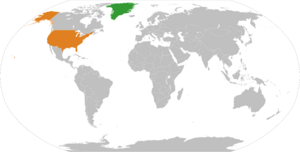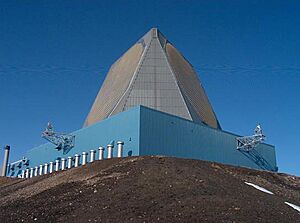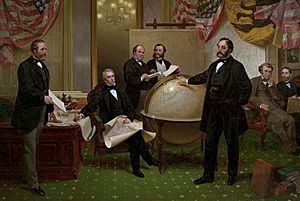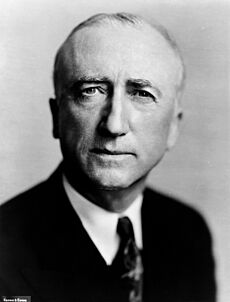Proposals for the United States to purchase Greenland facts for kids
Since 1867, the United States has thought about or made offers to buy the island of Greenland from Denmark. They did this before with the Danish West Indies in 1917. Even though Greenland is a self-governing part of the Kingdom of Denmark, a treaty from 1951 gives the United States a lot of control over the island's defense. The U.S. once even claimed parts of Greenland because of early explorations.
Contents
Why the U.S. Wanted Greenland
Early Claims on Greenland
In 1261, Norse (Viking) settlements in southern Greenland agreed to be ruled by Norway. Even though these settlements disappeared by the 1400s, Norway still claimed the land. After Denmark and Norway joined in 1537, Denmark–Norway continued these claims.
Starting in 1721, missionaries and traders from Denmark-Norway began to settle southern Greenland again. In 1775, Denmark-Norway officially made Greenland a colony. In 1814, Greenland was formally given to Denmark by the Treaty of Kiel. Denmark then tried to colonize the whole island in the 1880s.
The United States also had strong claims to parts of Greenland. Much of the island was unexplored back then. An American explorer named Charles Francis Hall was the first to see northwest Greenland. Later, Robert Peary claimed much of the northern part.
During World War I, when the U.S. wanted to buy the Danish West Indies, Denmark said the U.S. had to recognize Denmark's claim over all of Greenland. The U.S. Secretary of State, Robert Lansing, agreed in 1917. This stopped the United Kingdom from trying to get the first chance to buy Greenland if Denmark ever sold it. The British had wanted to buy Greenland for Canada to prevent the U.S. from getting it.
Since 1823, the United States has followed the Monroe Doctrine. This rule opposes other countries expanding their power in the Americas. Lansing's agreement was an exception. In 1919, Denmark asked other nations to recognize its full control over Greenland. Canada, France, Japan, Italy, and Sweden agreed. Denmark officially declared control over all of Greenland in 1921. Norway tried to reclaim a part of Greenland in 1931, but a court ruled against them, saying the claim belonged to Denmark.
Greenland in the 20th Century
Robert Peary, the explorer, did not want the U.S. to give up its claims on Greenland. He believed it went against the Monroe Doctrine. He wanted the U.S. to buy the island for its valuable minerals and to prevent other countries from building bases there. These bases could threaten the U.S. as air and sea technology improved.
During World War I, the U.S. decided that getting the Danish West Indies was more important for defending the Panama Canal. But in the 1920s, General Billy Mitchell wanted U.S. air bases on Greenland and Iceland.
By the early 1940s, the U.S. government agreed that Greenland was very important for its Arctic plans. Before World War II, Greenland was part of a U.S. defense plan called RAINBOW 4. This plan imagined the U.S. being attacked from all sides. In this plan, American forces would take over all Dutch, Danish, and French lands in the Western Hemisphere, including Greenland, to create a defensive shield.
When Germany invaded Denmark on April 9, 1940, Greenland's legal situation changed. Because Greenland was close to North America, had the only known source of a mineral called cryolite, and Germany tried to use the island for weather reports, the U.S. applied the Monroe Doctrine to European colonies in the North Atlantic for the first time.
The U.S. sent armed United States Coast Guard personnel to Greenland to secure the territory. To avoid looking like an invasion, the Coast Guardsmen were temporarily discharged and became "volunteers." This was a legal trick because the U.S. was neutral, and Denmark's government-in-exile had not agreed to the landing. Later, the Danish government did agree, and the United States Army occupied the island in 1941.
In 1946, U.S. military leaders listed Greenland and Iceland as two of the three most important international places for American bases. When NATO was formed, these islands were seen as more vital for American and Canadian defense than some Western European countries. Greenland is on the shortest polar route between Washington D.C. and Moscow.
Since Denmark cannot defend an island 50 times its own size, it signed a treaty with the U.S. in April 1951. This treaty gave the U.S. special control over defense areas in Greenland. Denmark knew that without this agreement, Greenland would likely become closer to the U.S. anyway. The U.S. military told President Dwight Eisenhower that Denmark was "very cooperative." One Danish expert later wrote that Denmark's control over Greenland during the Cold War was mostly pretend, and the U.S. had real control.
Around 1953, the U.S. built Thule Air Base in northern Greenland. From 1959, Greenland was part of NORAD, a joint U.S.-Canadian air defense system. Thule Air Base employed over 1,000 Greenlanders and had almost 10,000 American staff. It and about 50 other U.S. bases tracked Soviet submarines. Camp Century was an experiment in building under ice. The canceled Project Iceworm would have hidden 600 missiles under the ice.
After the Cold War ended, U.S. interest in Greenland decreased. Many radars were abandoned. Today, Thule Air Base is the only U.S. base, with a few hundred Americans. This decrease in U.S. interest disappointed many Greenlanders.
Greenland in the 21st Century
The United States, Russia, and China have paid more attention to Greenland and the Arctic region in the early 21st century. In 2019, a professor from the University of Greenland noted that the U.S. was "waking up to Arctic reality" because of Russia and China.
United States' Interest
In 2007, the American Ambassador to Denmark, James P. Cain, wrote that Greenland would likely become independent. He believed the U.S. should prepare by talking directly with Greenland. He said U.S. programs in education, culture, and science would strengthen ties and keep China out.
Greenland is still important for American and NATO security. An expert from the Naval War College said in 2019, "Whoever holds Greenland will hold the Arctic." The U.S. sees Greenland as part of North America. U.S. officials often visit the island. In 2018, the U.S. Navy brought back the United States Second Fleet, which covers the North Atlantic. An agreement was signed to invest in shared infrastructure. Greenland welcomed this. The island could be where the U.S. builds a new strategic Arctic port.
In 2019, Greenland asked the U.S. for an aerial survey to find mineral resources. In April 2020, Greenland accepted a $12.1 million grant from the U.S. In December 2019, Denmark approved a U.S. request to reopen a consulate in Greenland. This consulate, first opened during WWII and closed in 1953, reopened in June 2020. An expert called these actions "monumental" for Arctic policy.
In October 2020, Reuters described Greenland as a "security black hole" for the U.S. and its allies. Its long coastline is hard to monitor. Foreign ships, including a Russian submarine, have been found unexpectedly in waters Denmark aims to defend. There are worries about Russian ships mapping the ocean floor or cutting undersea cables.
China's Interest
China declared itself a "near-Arctic state" in 2018. China's interest in Greenland began in 2005 when Greenland's Prime Minister visited China. China is interested in Arctic science, building projects, and natural resources. Greenland wants outside investments. China is the largest outside investor in Greenland. A Chinese mining company owns part of Greenland Minerals, which plans to extract minerals at Kvanefjeld. China is Greenland's second-largest export partner after Denmark.
China also works with Greenland on scientific projects and promotes Chinese culture. In 2016, Greenland allowed China to build a research station. In 2017, Denmark stopped a Chinese company from buying an old naval base in Greenland because it worried about relations with the U.S. When Greenland's prime minister asked China for money to build two airports, the U.S. convinced Denmark to provide the money instead. As of February 2021, three airport projects are planned in Greenland.
Denmark's Role
Greenland gives Denmark a role in the Arctic, making it a member of the Arctic Council. However, Danish investors have little presence in Greenland. Denmark's Arctic Command has limited resources to patrol the entire island.
In 2019, Denmark announced it would spend money to monitor Greenland. In 2020, Denmark's Foreign Ministry sent an advisor on security to Greenland's government. Some believe this was to ensure Denmark was involved in communications between Greenland and the new U.S. consulate. Denmark's Minister of Defence said increased U.S. cooperation with Greenland was good.
European Union's Role
A 2020 report said the European Union's (EU) involvement with Greenland was small. After Greenland left the European Communities in 1985, it remained connected as an "Overseas Country and Territory," and Greenlanders are EU citizens. The EU gives Greenland an annual payment, but it's not expected to increase much. The EU needs its own source of rare earth minerals and wants to rely less on China. This might increase its interest. The European Commission signed a minerals agreement with Greenland in November 2023 and opened an office in Nuuk in March 2024.
Greenland's Political Status
Greenland is a self-governing area within the Kingdom of Denmark. Many Greenlanders did not like Denmark interfering in the airport deal. Greenlandic independence is possible under Danish law. In February 2024, Greenland stated that independence is its goal.
With Greenland Home Rule, elected leaders manage most internal affairs. Denmark handles foreign affairs and guards sea borders. The United States controls external defense. The U.S. cannot increase its presence without Denmark and Greenland's approval. However, under the 1951 agreement, the U.S. pays no rent for its bases. It has almost complete authority within "defense areas" agreed upon with NATO. U.S. forces can move freely and fly over the island. Denmark has little power to act in Greenland when U.S. national security is involved.
The U.S. presence helps Denmark maintain control over the island and allows Denmark to spend less on NATO. Greenlandic governments want to join NATO as an independent country. They welcome U.S. interest if Greenland benefits from U.S. investments in jobs and infrastructure.
As of 2017, Denmark is Greenland's largest trade partner. As of 2019, Denmark gives Greenland about 4.3 billion Danish kroner annually. About two-thirds of Greenlanders support independence, but most don't think it's possible without Denmark's financial help.
Greenland, which is three times the size of Texas, has huge natural resources like uranium, rare-earth minerals, and oil and gas. But it has only one working mine and little infrastructure. It has only one international airport, and no roads connect its 17 towns. Denmark has given Greenland control over its raw materials. However, a 2014 report said that replacing Denmark's financial help would need 24 large projects, each costing 5 billion Danish kroner. Since no investors were found, the report said Greenland would depend on Denmark for at least 25 years.
Denmark was hesitant to pay for the airports because it saw Greenland seeking investment as a step toward independence. An Icelandic expert suggested Greenland should see Denmark as one of many options and that the U.S. or Canada might offer more funding.
Proposals to Buy Greenland
1867 Proposal
In 1867, U.S. Secretary of State William H. Seward bought Alaska from Russia. That same year, he thought about the U.S. buying both Greenland and Iceland. In 1868, talks to buy both islands from Denmark for $5.5 million were almost finished. Seward asked for a report on the resources of Iceland and Greenland, but he never made an official offer.
1910 Proposal
In 1910, the U.S. Ambassador to Denmark, Maurice Francis Egan, discussed buying Greenland. Danish officials suggested that the U.S. could trade two islands, Mindanao and Palawan, for Greenland and the Danish West Indies. Denmark could then trade Mindanao and Palawan to Germany for Northern Schleswig. Denmark later got Northern Schleswig back after World War I.
1946 Proposal
In 1946, the United States offered Denmark $100 million in gold for Greenland. A U.S. Senator said in November 1945 that buying the island was "a military necessity." The U.S. military believed that getting the island, which was "completely worthless to Denmark," was vital for the U.S.
A State Department official agreed that few people in Denmark cared about Greenland. Owning it would give the U.S. bases to launch military operations over the Arctic. He suggested the $100 million price. Secretary of State James F. Byrnes made the offer on December 14, 1946, to the Danish foreign minister, Gustav Rasmussen.
The U.S. preferred to buy Greenland. They believed it would be better for Denmark, preventing criticism of U.S. bases on Danish land and saving Denmark money. The U.S. told Denmark that a sale "would be the most clean-cut and satisfactory."
Rasmussen was surprised by the offer. Rumors about the U.S. wanting to buy Greenland were circulating. The Danish government believed the U.S. would leave Greenland after World War II. They did not know the U.S. saw the Soviet Union as a new threat.
Rasmussen declined all options and returned to Denmark. He told the U.S. Ambassador, "While we owe much to America, I do not feel that we owe them the whole island of Greenland." The offer surprised Rasmussen because of some confusion caused by the Danish Ambassador to the U.S., who had supported an American presence in Greenland without fully informing his government.
Time magazine reported in January 1947 that Greenland would be as valuable as Alaska for defense. The magazine noted that Denmark owed U.S. investors money and needed dollars. Rumors in Copenhagen said the price for the island could be $1 billion.
Selling Greenland might have helped Denmark return to its traditional neutrality and provided much-needed funds after the war. However, all Danish political parties rejected selling the island. They saw Greenland as part of their national identity and history, not just an investment. Denmark also planned to expand trade and resource extraction there.
By offering to buy Greenland, the U.S. showed Denmark it was not likely to leave. Denmark did not fully understand Greenland's strategic importance to the U.S. until later. The legal status of the 1941 agreement was unclear.
After the 1947 Danish election, the new government continued to keep the U.S. interest secret from the public. The 1947 offer was kept secret until the 1970s.
By spring 1948, Denmark gave up trying to make the Americans leave. Denmark joined NATO partly because the U.S. presence in Greenland meant the Soviet Union already saw Denmark as a U.S. ally. The April 1951 agreement between Denmark and the U.S. stated it would remain as long as the NATO treaty did.
2019 Proposal

In 2019, U.S. President Donald Trump discussed buying Greenland with his advisors. Senator Tom Cotton had suggested buying the island to the Danish ambassador in August 2018. Supporters of the idea talked about expanding the American partnership with Greenland, possibly including a purchase. One official said the U.S. could give Greenland more money than Denmark does. Senator Cotton said he suggested the purchase because of Greenland's importance for U.S. security and its economic potential.
When the Wall Street Journal reported on Trump's discussions in August 2019, Greenland's Premier Kim Kielsen, Greenland's Minister of Foreign Affairs, and Denmark's Prime Minister Mette Frederiksen all rejected a sale. They said things like "Greenland is not for sale" and called the idea "completely ridiculous." Frederiksen said, "Greenland is not Danish. Greenland is Greenlandic." She also said Denmark wanted to continue its close relationship with the U.S. and was open to more U.S. military presence.
2024 Proposal
After Donald Trump was re-elected in November 2024, one of his allies, Representative Mike Collins, posted a picture of Greenland on an electoral map, suggesting Trump might try to buy Greenland again. On November 25, Alexander Gray, who worked for Trump before, suggested an independent Greenland could sign a special agreement with the U.S. for economic and military help. He called it "the deal of the century." On December 22, Trump posted that U.S. "ownership and control of Greenland is an absolute necessity" for national security and "world freedom." He said this while announcing his new ambassador to Denmark.
Other Proposals
In 1939, U.S. Secretary of State Cordell Hull's staff advised him not to offer to buy Greenland. The Secretary of War said the island was too far from American sea or air routes. In the 1970s, U.S. Vice President Nelson Rockefeller suggested buying Greenland for mining. This idea was first made public in 1982.
Previous U.S. Purchases of Danish Land
In 1917, Denmark sold the Danish West Indies to the United States. These islands were renamed the United States Virgin Islands and became a U.S. territory.
Why the U.S. Wants Greenland
Buying Greenland would give the U.S. permanent control of an island vital for its defense. The U.S. would gain huge amounts of natural resources, including oil, gas, and rare minerals. Greenland has the largest deposits of rare earths outside China. Climate change might make the Northern Sea Route ice-free by 2030. This route would connect the Atlantic and Pacific Oceans, making Greenland's resources much easier to reach. If the U.S. bought Greenland, it would become the second-largest country in the world by land area, after Russia. It would be the biggest land purchase in American history, even larger than the Louisiana Purchase.
Estimates for Greenland's Price
In August 2019, Washington Post estimated Greenland's price could be between $200 million and $1.7 trillion. A middle estimate was $42.6 billion. The lower price was based on what the U.S. paid for Alaska, adjusted for inflation and size. The higher price considered the future value of its minerals and the possibility of it becoming a place to live due to climate change.
Another estimate was $1.1 trillion. This included $300-400 billion for potential oil fields, $500-700 billion for rare-earth minerals, and $200-220 billion for real estate. One analysis said that if the U.S. wants Greenland for its strategic value and military power, $500 billion is not too much.
See also
- Hans Island – a Greenland island that Canada and Denmark used to argue over
- Territorial expansion of the United States
- 51st state § Greenland
- List of territory purchased by a sovereign nation from another sovereign nationfr:Histoire du Groenland#Propositions de rachat par les États-Unis





